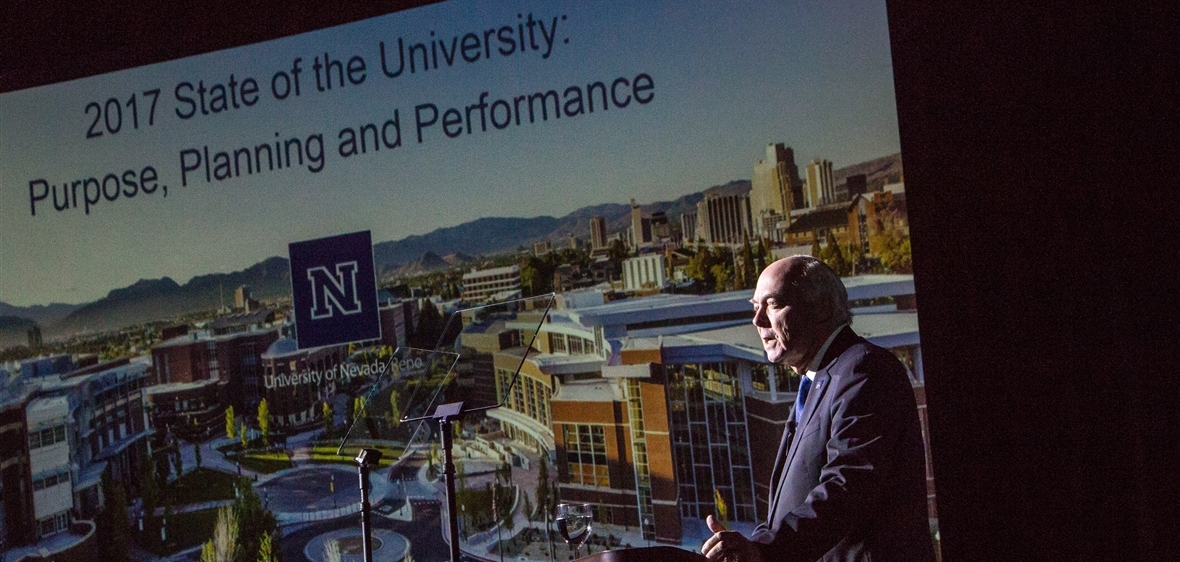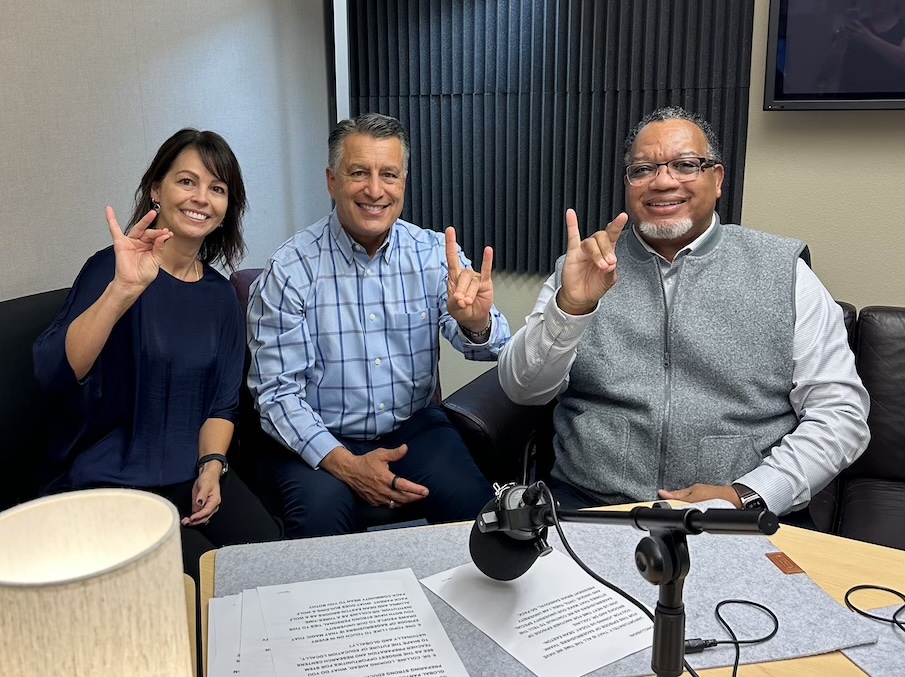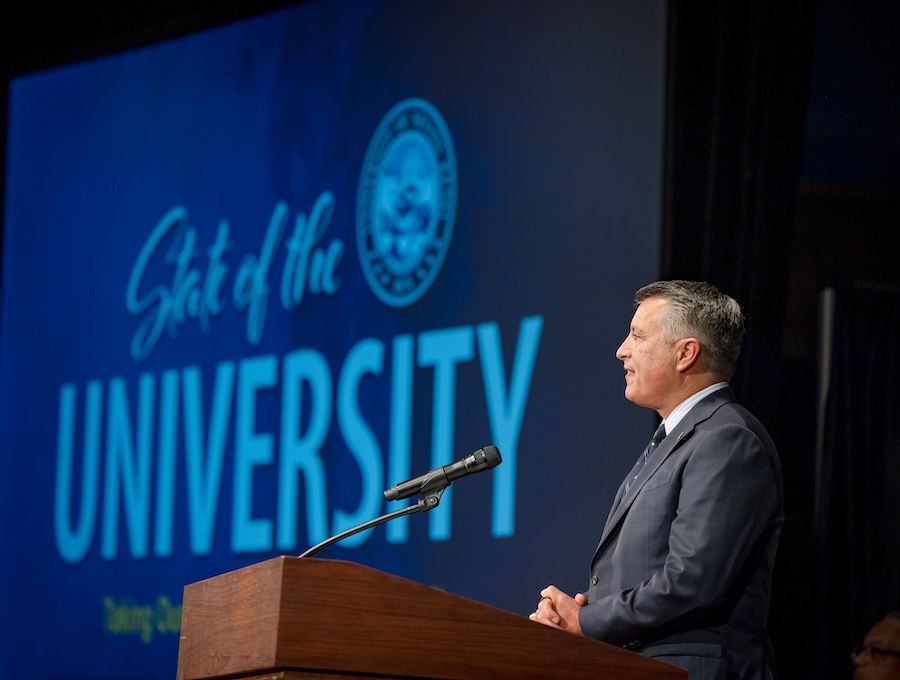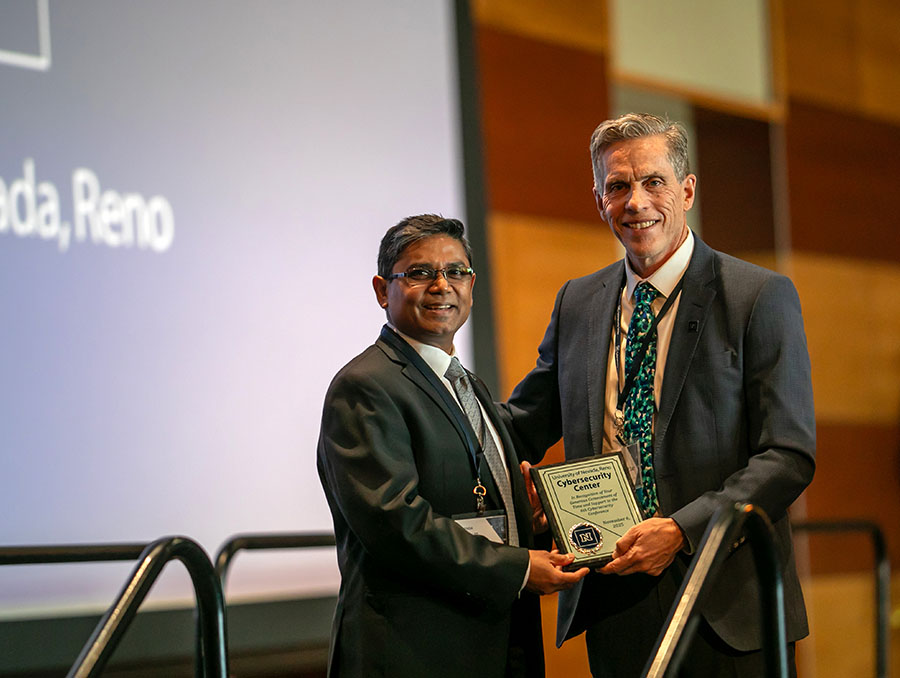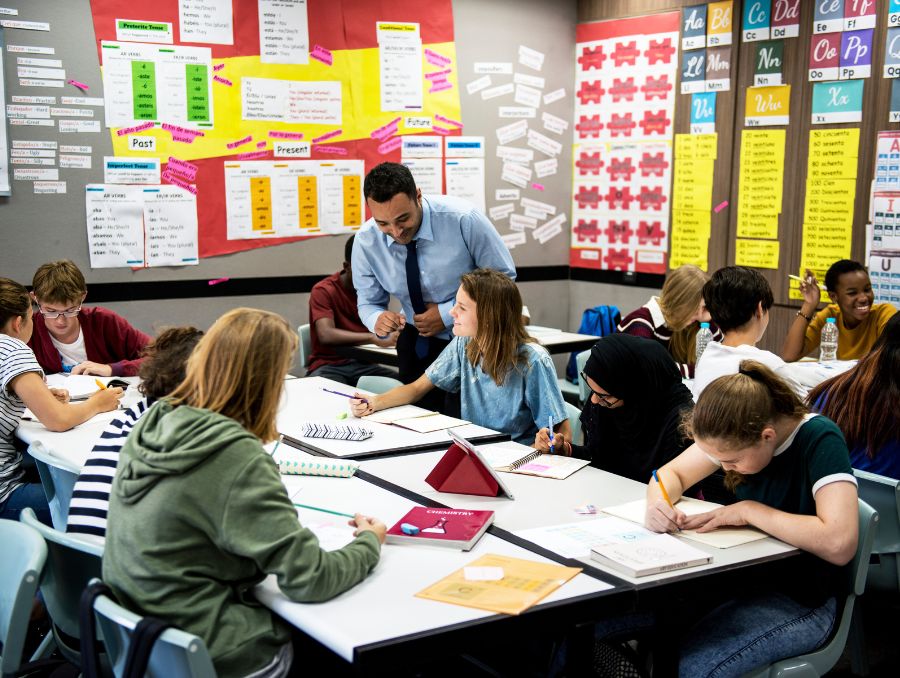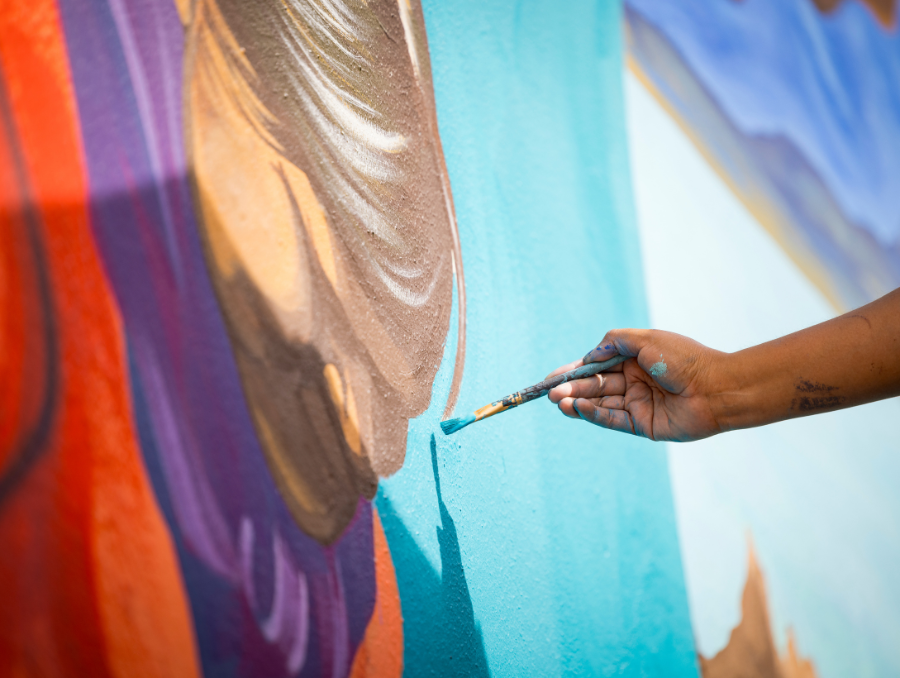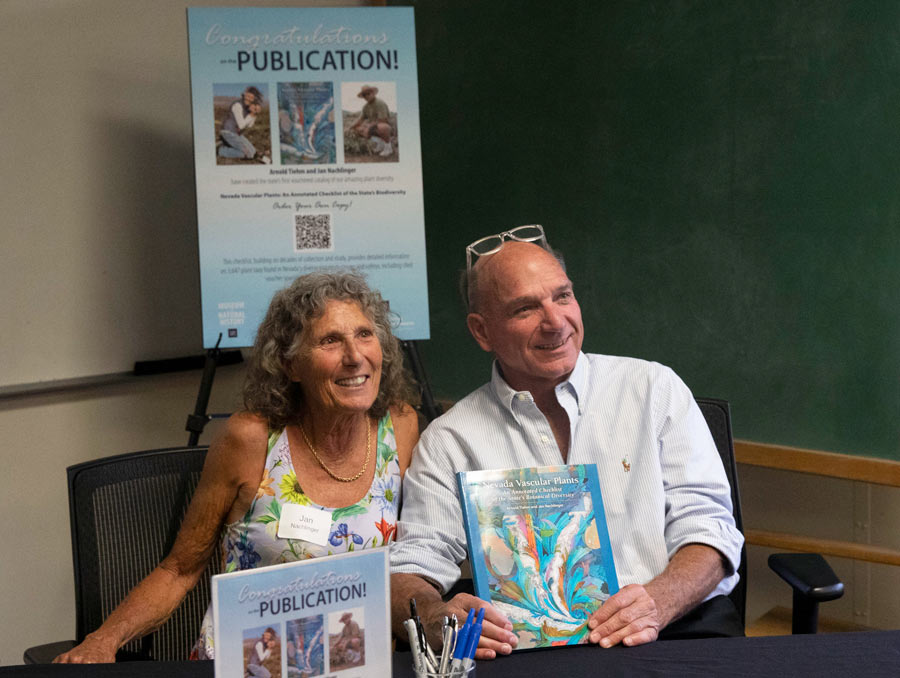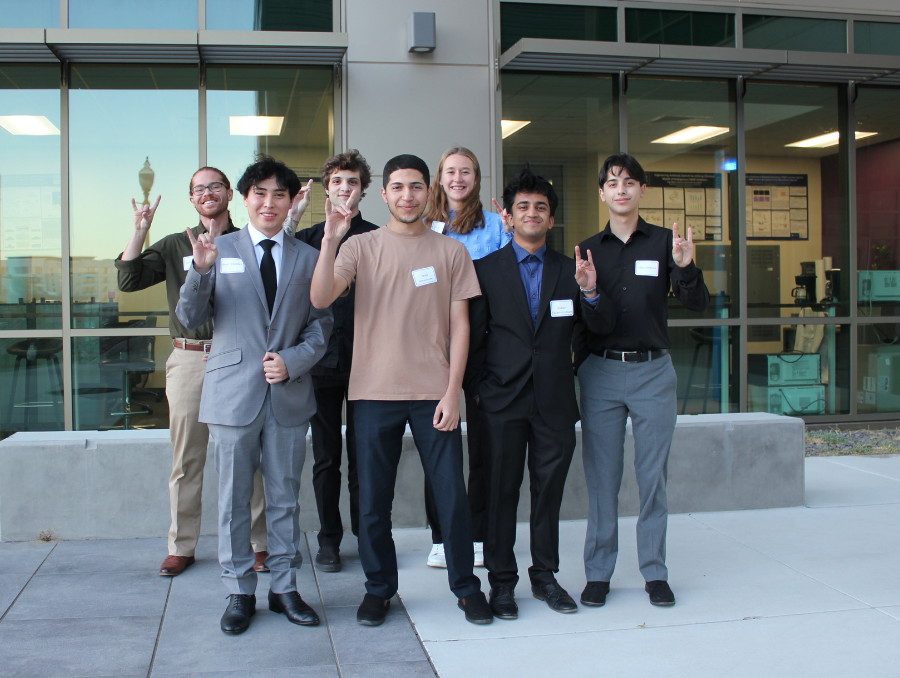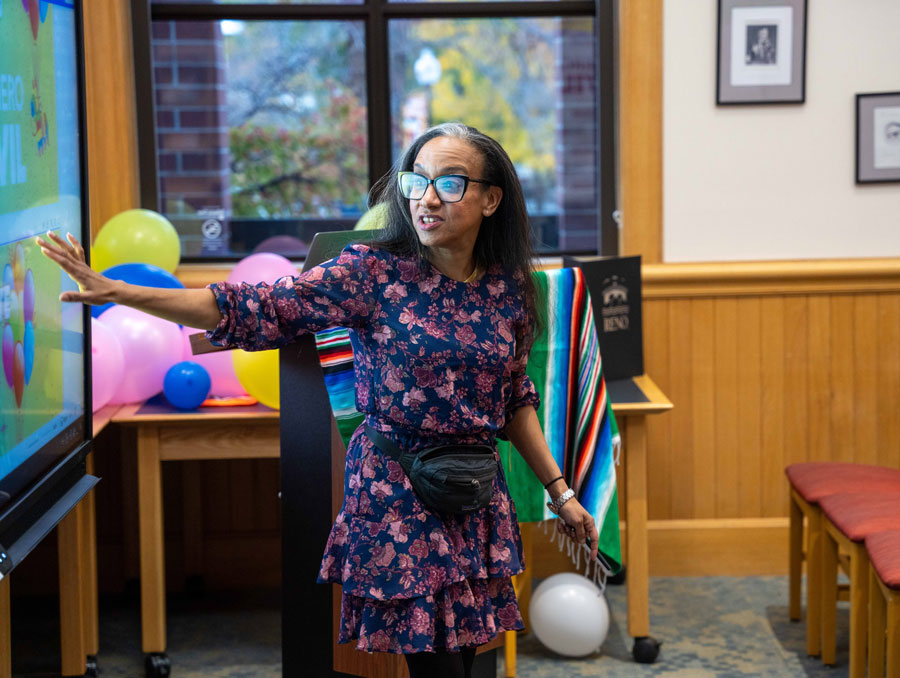President Marc Johnson updated the campus on the progress being made and the path forward in achieving several of the University's "big goals" during his annual "State of the University" address on Tuesday in the Glick Ballrooms of the Joe Crowley Student Union.
During a 42-minute address before about 250 people, Johnson emphasized that fulfilling three of the University's most important institutional goals, which include reducing class sizes while maintaining quality experiential learning, reaching the Carnegie Classification of "R-1" as a high impact research university and in serving as an economic pillar for Nevada, are well within reach of the campus.
He touted the "entrepreneurial spirit and momentum reflecting resolve to be a top-ranked university" that has been shown by the campus since the great recession of 2008-2009.
"Our actions support student success in achieving their degrees and confidence in their abilities to make a difference," he said. "Our actions support administrative and academic faculty in finding fulfillment in building careers here. Our actions support the development of the New Nevada with economic diversification to provide stable growth.
"All of these goals and our actions to achieve these goals are about creating opportunities for our students, classified employees, administrative and academic faculty, and members of Nevada's communities."
Johnson noted that several institutional milestones have already been met in recent years, including record number of graduates (nearly 4,400 in the past year), retention (81 percent), diversity (37.5 percent), philanthropy (the University has had three of its best fund-raising years ever recently) as well as enrollment, which saw fall 2017 enrollment reach 21,657 students.
Managing such growth has been a challenge, though Johnson said the University has been "intentional" in developing revenue and fund-raising streams to increase the University's offerings in the form of new buildings, the hiring of 217 new faculty since 2014, as well as research and innovation partnerships and points of emphasis to better connect with business and develop a more diversified knowledge-based economy for Nevada.
Professor of Counseling and Chair of the University's Faculty Senate Tom Harrison
Johnson said the University has used careful financial analysis to fund new student on-campus residences and renovation of old residential spaces, and has increasingly found new ways to fund capital improvement projects without a lot of additional state support.
"All of the construction which has gone into this campus is intentional, well-planned, and carefully financed to accommodate stable growth," he said. "In fact, since 2012, the University has invested $458.4 million in capital projects using only $65.4 million in state funds."
Below is a brief encapsulation of what Johnson described as the University's "three big goals" and where he said the University stands in achieving them.
Goal 1: Respond to enrollment growth with quality, experiential learning and move toward a student-to-faculty ratio of peer median, 18:1
In addition to record numbers of students and new student-centered buildings, such as the William Pennington Student Achievement Center and the E. L. Wiegand Fitness Center, Johnson said the hiring of more than 200 faculty - with a goal of reaching 400 in the next few years - has helped reduce student-to-faculty classroom ratios from 22 to 1 in 2014 to 20 to 1 this fall.
New buildings, plus renovation of old buildings such as Lincoln Hall and Palmer Engineering, have helped accommodate faculty growth as well, Johnson said. In the last four years, he said, the University added 181 faculty offices and 15,000 square feet of research and creative spaces with new construction and renovations, and "future buildings will add even more," he said.
"The University has done a lot to grow office facilities for faculty, employee, and student growth, but we are aware that quality laboratory spaces remain a challenge and we are working on design and financing plans for this issue," Johnson said.
Goal 2: Develop a high-impact research university measured by the Carnegie classification R-1
Johnson said the R-1 is within reach of the University once several crucial tipping points are met. He said the University, thanks in part to record faculty productivity, comprehensive support services that have been put in place by Vice President for Research and Innovation Mridul Gautam and increases in tenure-track positions as well as graduate assistantships reached nearly $100 million in research expenditures in FY 2017.
ASUN President Noah Teixeira
"We anticipate this figure to rise to $130 million within two years which will take the University of Nevada, Reno toward the goal of being classified as R-1 by the Carnegie Foundation," he said. "We probably need to raise this level to at least $150 million to achieve the classification."
The benefits of reaching R-1, Johnson said, are many. He noted that the University will become more of a "destination" for faculty who wish to pursue fulfilling and meaningful careers as well as for top undergraduate and graduate students who will benefit from exposure to quality faculty and excellent research facilities. He also said that the Nevada has the largest population of the 10 states without an R-1 research university.
"Surrounding states like Arizona, Oregon and Washington have two," he said. "Earning the classification of Carnegie R-1 will bring pride to Nevada as a significant contributor to the state of knowledge and will be a point of pride for the people of Nevada."
There are also clear economic benefits associated with R-1, Johnson said. He cited an economic analysis recently completed by the University that showed that the University's $1.1 billion annual economic impact would leap to $1.4 billion once it reaches R-1. The figure would include the additional generation of 2,000 high-income jobs.
More than anything, however, Johnson said the University will benefit from R-1 simply because of the ways the University will grow in the quest to reach R-1. "As you can see, we are well on our way," he said. "I will restate as I have many times that the arrival at the classification of R-1 is not as important as the journey to grow the research enterprise to warrant the classification and the many benefits of a vibrant research enterprise for students, faculty and the community."
ASUN Speaker Hannah Jackson
Goal 3: Serve as a pillar of economic development in the New Nevada
"In addition to educating a professional workforce and providing new technologies for our diversifying community, engagement with leadership and the businesses and agencies will enhance their efforts to a smoother, faster path toward development," Johnson said of this goal. "The University is a full partner in achieving the New Nevada. The University provides talent, innovation and space to assist partners in the community, which creates a nexus of creativity, innovation and economic momentum."
Notable inroads and connection with the community and the state have been ongoing, Johnson said. He cited the impact that the Innevation Center, Powered by Switch on 450 Sinclair Street has had in nurturing business partnerships in the community, creating startups and spinoffs, and in helping set the stage for another partnership with Switch - the housing of the University's high-performance computing - which he said is "worth several million dollars over the next few years."
He also touted the Biological Entrepreneurship Lab (BEL), created in the Applied Research Building to provide access to expensive analytical equipment for campus and community innovators. "In just a few months, the BEL has attracted startup businesses to Reno from Chicago and the Bay Area because they just could not access similar equipment in other locations. Access is golden," he said.
Johnson also spoke for several minutes about Diversity, an area which he said is "is fundamental to the practice of our values of our University."
ASUN Chief of Staff Carissa Bradley
"We certainly were challenged shortly before the beginning of the year with an association with a student at the Charlottesville white nationalist event, he said. "We were able to rally our campus together to reaffirm our values of inclusion and repudiate bigotry and white supremacy."
Johnson said he was "extremely proud of the efforts of our students, faculty and staff to engage in meaningful, thoughtful dialogue and in offering constructive ideas to make our campus more diverse and inclusive. At the beginning of the semester, several faculty members drafted an open letter to our students which reinforced our core values and assured our students we are here to stand with them. I was proud to sign this letter along with the Provost, our administration and hundreds of other faculty and staff. Student activity in the areas of inclusion and diversity has been remarkable as well. Our students continue to show us how to reach a better understanding of these important issues. Let's applaud our students for their energy, creativity and ideas."
GSA President Sandesh Kannan
He said an area of emphasis is "to strive, even more effectively than we have, to diversify our faculty." Johnson said the work of the Faculty Senate Diversity Committee was central to improving campus faculty searches and that this year, the University is requiring that anyone on a search committee for a faculty position take implicit bias training before looking at applications.
"Additionally, we are investing in diversity by adding 11 positions, six tenure track faculty positions in Gender, Race and Identity between the College of Liberal Arts and Central Administration, two Title IX investigators, one community service specialist to help students and their families adjust to changing conditions, especially related to immigration issues, one website specialist to assure accessibility to websites and learning materials for the sight and hearing impaired students, and one position in the Office of Diversity Initiatives," he said.
Communications Studies Instructor and Assemblywoman Jill Tolles
He added that the Diversity Core Objective in the Core Curriculum is being reviewed at the request of students to assure that this element of the Core Curriculum focuses on providing experience and understanding of contemporary issues of diversity. He said "significant effort is being devoted to help our Deferred Action for Childhood Arrivals students find their way toward graduation through a very tense and shifting political and policy environment."
In conclusion, Johnson said he is confident the University will achieve its major goals. "The University is recognized as a friendly place where people care about each other and where people serve one another with grace," he said. "With intentional purpose and deliberate planning over the past several years, we have achieved record-setting institutional performance. "With so many talented people coming together in this important pursuit of all of our core objectives, we will achieve our big goals."
Read the full transcript of the 2017 State of the University Address.
